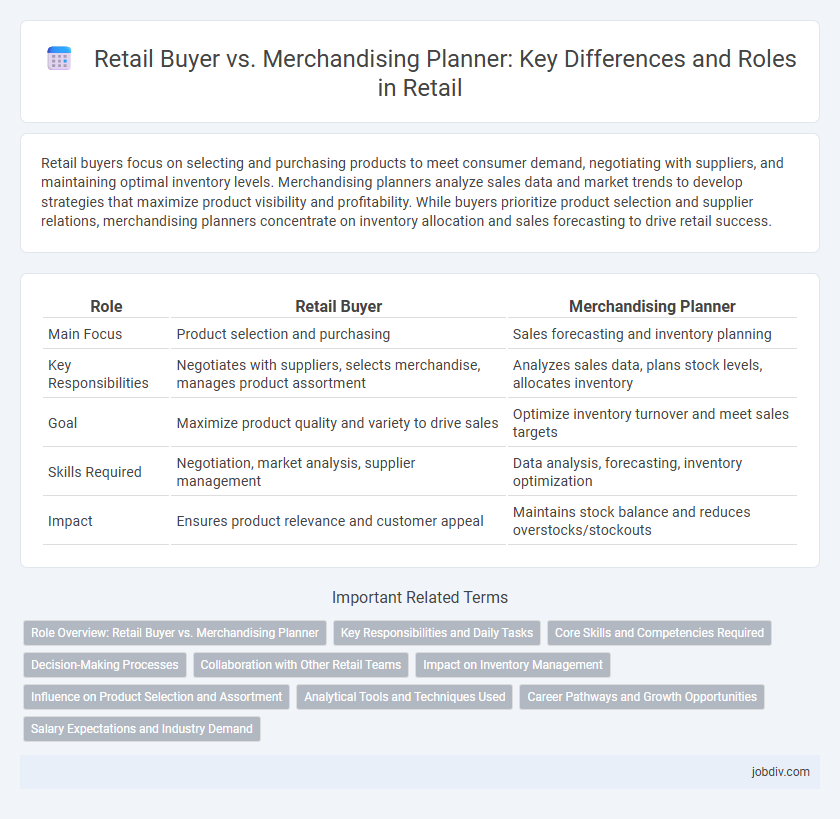Retail buyers focus on selecting and purchasing products to meet consumer demand, negotiating with suppliers, and maintaining optimal inventory levels. Merchandising planners analyze sales data and market trends to develop strategies that maximize product visibility and profitability. While buyers prioritize product selection and supplier relations, merchandising planners concentrate on inventory allocation and sales forecasting to drive retail success.
Table of Comparison
| Role | Retail Buyer | Merchandising Planner |
|---|---|---|
| Main Focus | Product selection and purchasing | Sales forecasting and inventory planning |
| Key Responsibilities | Negotiates with suppliers, selects merchandise, manages product assortment | Analyzes sales data, plans stock levels, allocates inventory |
| Goal | Maximize product quality and variety to drive sales | Optimize inventory turnover and meet sales targets |
| Skills Required | Negotiation, market analysis, supplier management | Data analysis, forecasting, inventory optimization |
| Impact | Ensures product relevance and customer appeal | Maintains stock balance and reduces overstocks/stockouts |
Role Overview: Retail Buyer vs. Merchandising Planner
Retail Buyers focus on selecting and purchasing products to meet customer demand and maximize sales profitability, leveraging market trends and supplier negotiations. Merchandising Planners analyze sales data, forecast inventory needs, and develop merchandise strategies to optimize stock levels and enhance product assortment. Both roles collaborate closely to ensure product availability aligns with consumer preferences and retail business objectives.
Key Responsibilities and Daily Tasks
Retail Buyers focus on selecting and purchasing products that meet consumer demand, negotiating with suppliers, and managing inventory levels to maximize profitability. Merchandising Planners analyze sales trends, forecast demand, and develop assortment strategies to optimize product placement and stock allocation across retail channels. Both roles collaborate to ensure the right products are available at the right time, balancing customer needs with business goals.
Core Skills and Competencies Required
Retail Buyers excel in negotiation, market analysis, and supplier relationship management to secure optimal product assortments at competitive prices. Merchandising Planners focus on data-driven forecasting, inventory optimization, and sales trend analysis to align stock levels with consumer demand. Both roles require strong analytical skills, effective communication, and a deep understanding of retail market dynamics to drive profitability.
Decision-Making Processes
Retail Buyers analyze market trends and customer preferences to select and purchase products that align with the company's sales goals, relying heavily on real-time sales data and supplier negotiations for informed purchasing decisions. Merchandising Planners use historical sales data, inventory levels, and forecasting models to allocate budgets and plan product assortments that maximize profitability and minimize stockouts or overstocks. Both roles collaborate closely, but Buyers focus on product acquisition choices while Merchandising Planners emphasize strategic inventory and financial planning to drive retail success.
Collaboration with Other Retail Teams
Retail buyers collaborate closely with merchandising planners to align purchasing decisions with inventory forecasts, ensuring optimal product availability and sales performance. Merchandising planners provide data-driven insights on sales trends and stock levels, enabling buyers to make informed decisions about product selection and allocation. Their seamless cooperation enhances inventory turnover and maximizes profitability across retail teams.
Impact on Inventory Management
Retail buyers directly influence inventory levels by selecting and purchasing products based on market demand and sales forecasts, ensuring stock availability aligns with consumer preferences. Merchandising planners analyze sales data and market trends to optimize inventory allocation, balancing product assortment and minimizing stockouts or overstock situations. Effective collaboration between retail buyers and merchandising planners enhances inventory turnover and reduces holding costs, driving overall retail profitability.
Influence on Product Selection and Assortment
Retail buyers directly influence product selection by evaluating supplier offerings, negotiating terms, and choosing products that meet consumer demand and profitability goals. Merchandising planners impact assortment by analyzing sales data, forecasting trends, and optimizing stock levels to ensure the right mix of products across retail channels. Both roles collaborate to balance market trends, inventory turnover, and customer preferences, driving effective merchandise assortments that boost sales performance.
Analytical Tools and Techniques Used
Retail buyers utilize sales forecasting software and inventory management systems to optimize product selection and negotiate supplier contracts, emphasizing demand analysis and market trends. Merchandising planners leverage data visualization tools and predictive analytics to plan assortment strategies, manage stock levels, and enhance pricing models for maximizing profitability. Both roles employ advanced Excel functions and business intelligence platforms such as Tableau or SAP Analytics Cloud to support data-driven decision-making.
Career Pathways and Growth Opportunities
A Retail Buyer typically focuses on selecting and purchasing products that align with market demand and consumer trends, providing a direct impact on inventory and sales performance. In contrast, a Merchandising Planner analyzes sales forecasts, stock levels, and financial data to optimize product availability and maximize profitability. Career growth for Retail Buyers often leads to senior purchasing or category management roles, while Merchandising Planners can advance into strategic planning or commercial leadership positions within retail organizations.
Salary Expectations and Industry Demand
Retail buyers typically command higher salaries, with averages ranging from $60,000 to $90,000 annually, reflecting their strategic role in selecting and purchasing products that drive store profitability. Merchandising planners earn between $50,000 and $75,000, focusing on inventory allocation and sales forecasting to optimize stock levels and sales performance. Industry demand for retail buyers remains strong due to their direct impact on product assortment, while merchandising planners are increasingly sought after for their analytical skills in enhancing inventory efficiency and maximizing revenue.
Retail Buyer vs Merchandising Planner Infographic

 jobdiv.com
jobdiv.com